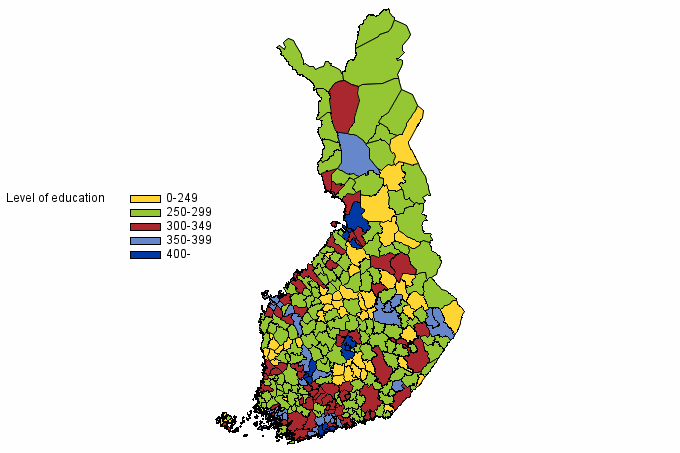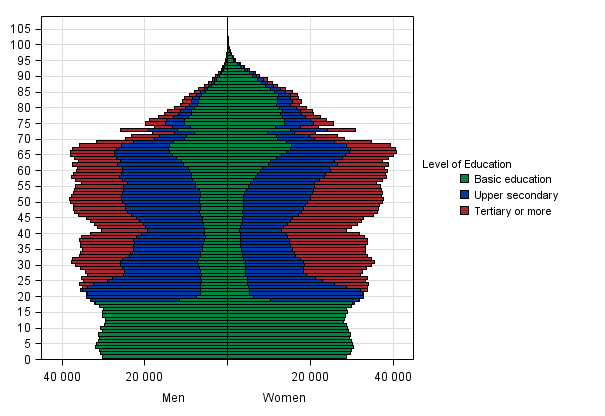Published: 5 November 2015
Considerable differences in educational levels between municipalities in 2014
By the end of 2014, altogether 3,213,533 persons, or 70 per cent of the population aged 15 or over had completed a post-comprehensive level qualification. Kauniainen had the population with the highest and Kivijärvi with the lowest educational qualifications. People living in Kauniainen had educated themselves for an average of 5.8 years after basic level education and people living in Kivijärvi for an average of 2.1 years.
Educational level of the population aged 20 and over by municipality in 2014

The highest educated population centres mainly around university towns and municipalities surrounding them, while the population with a lower level of education is more often located in rural municipalities. Measured by educational level, Kivijärvi and Kauniainen are at the extreme ends of the municipality division. In Kivijärvi, ten per cent of the population have tertiary qualifications and in Kauniainen, the corresponding figure is 57 per cent. Together with Kumlinge located in Åland, Kivijärvi and Kauniainen are the only municipalities where the male population is more highly educated than the female population. In Valkeakoski, men and women have an equal level of education, in addition to which, the difference between sexes in educational level measured by the length of education was small in Espoo, Kaskinen, Tampere and Pirkkala. The database tables of this statistics contain more information on, e.g. regional differences in educational levels (see database tables ).
Second generation immigrants with foreign background, i.e. those born in Finland, are mainly young people. In all, 69.5 per cent of second generation immigrants with foreign background belong to the age group 15 to 24, whose studying career is only beginning. The highest educated second generation immigrants with foreign background are persons aged 45 to 54, among whom 86.7 per cent have completed post-comprehensive level qualifications and 35.4 per cent tertiary level education. Measured by population share, persons aged 45 to 54 are nearly as highly educated as persons with Finnish background born in Finland, of whom 87.9 per cent have completed post-comprehensive level qualifications and 41.9 per cent tertiary level education.
Educational attainmet of second level immigrants with foreign background by age 2014
| Age | Total | Basic education or less (ISCED 2 or less) | Population with educational qualifications | Upper secondary /Post-secondary non tertiary education (ISCED 3/4) | ISCED 5 or more | |||||
| % | % | % | % | % | ||||||
| Total | 11 210 | 100,0 | 6 911 | 61,7 | 4 299 | 38,3 | 3 177 | 28,3 | 1 122 | 10,0 |
| 15-24 | 7 787 | 100,0 | 5 778 | 74,2 | 2 009 | 25,8 | 1 947 | 25,0 | 62 | 0,8 |
| 25-34 | 429 | 100,0 | 117 | 27,3 | 312 | 72,7 | 188 | 43,8 | 124 | 28,9 |
| 35-44 | 241 | 100,0 | 63 | 26,1 | 178 | 73,9 | 95 | 39,4 | 83 | 34,4 |
| 45-54 | 226 | 100,0 | 30 | 13,3 | 196 | 86,7 | 116 | 51,3 | 80 | 35,4 |
| 55-64 | 827 | 100,0 | 201 | 24,3 | 626 | 75,7 | 345 | 41,7 | 281 | 34,0 |
| 65-74 | 1 207 | 100,0 | 458 | 37,9 | 749 | 62,1 | 377 | 31,2 | 372 | 30,8 |
| 75- | 493 | 100,0 | 264 | 53,5 | 229 | 46,5 | 109 | 22,1 | 120 | 24,3 |
In 2014, there were 115,816 persons aged 20 to 29 with only basic level of education, which is 17.0 per cent of the age group. Among men, 19.0 per cent of the age group had only basic level education and 14.9 per cent among women. The share of those with only basic level education has decreased by 0.3 percentage points from last year. The proportion of men has declined by 0.7 percentage points, while the proportion of women has remained unchanged. The share of those with only basic level education was lowest at the beginning of the 2000s when the share was 16.4 per cent.
Population by level of education, age and gender 2014

Source: Education 2015. Statistics Finland
Inquiries: Mika Witting 029 551 3571, koulutustilastot@stat.fi
Director in charge: Jari Tarkoma
Publication in pdf-format (245.4 kB)
- Tables
-
Tables in databases
Pick the data you need into tables, view the data as graphs, or download the data for your use.
Appendix tables
Updated 5.11.2015
Official Statistics of Finland (OSF):
Educational structure of population [e-publication].
ISSN=2242-2919. 2014. Helsinki: Statistics Finland [referred: 17.1.2026].
Access method: http://stat.fi/til/vkour/2014/vkour_2014_2015-11-05_tie_001_en.html

